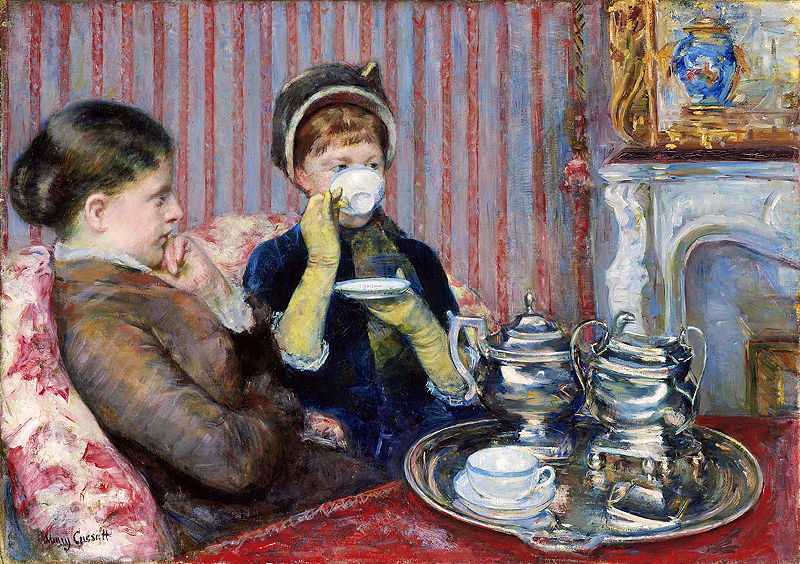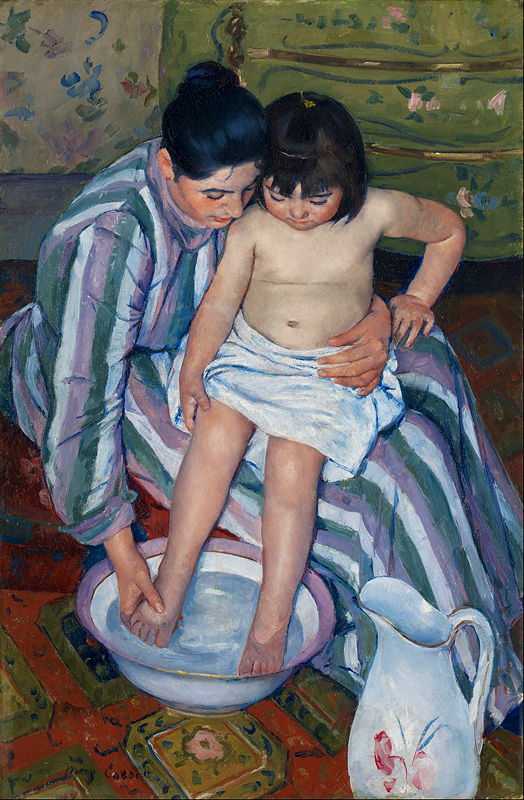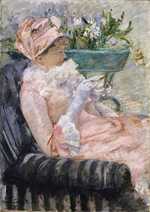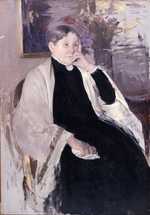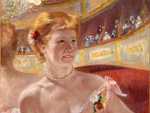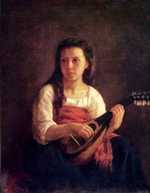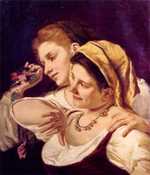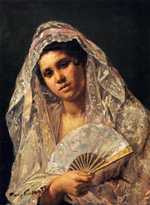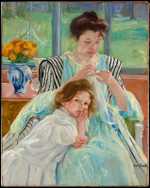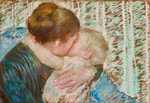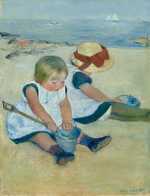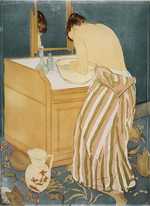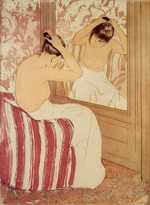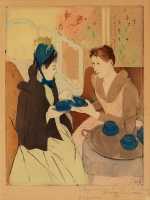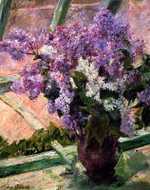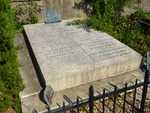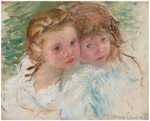1. Early Life
1844: Mary Cassatt is born in Allegheny City, Pennsylvania on 22 May, to Robert Simpson Cassatt, a prosperous stockbroker, and Katherine Kelso Johnston, who descended from an affluent banking family.
1851: Mary’s childhood years are spent in Europe. The Cassatt family travels when she is 7 years old to France and Germany, as a result of which the children become fluent in French and German and gain exposure to European life and culture.
1855: Paris World's Fair is held in 1855 and among the artists presented were famous names such as Courbet, Delacroix, Ingres, and Corot - which was probably Cassatt’s first exposure to French artists including the future impressionists, Pissarro and Degas, the latter of whom would become a close friend. Mary and her family return to America in 1855.
2. Cassatt's Formative Art Years
1861-65: Mary joins the Pennsylvania Academy of the Fine Arts at the age of 15 to study painting. She stays there for five years and quits in 1865, dissatisfied with the education and partly due to the patronizing environment of a mostly male establishment.
1866: Cassatt moves to Europe for better instruction in art. Her father is not supportive of this idea initially but gives in due to her persistence. In Paris, she is not allowed to join the École des Beaux-Arts on the account of being a woman. Cassatt joins the studio of Jean-Léon Gérôme, where she is also exposed to the works of Thomas Couture and Charles Chaplin.
Cassatt also becomes a copyist at the Louvre, where she meets other female artists who could not gather in cafes (where the impressionists typically socialised).
1868: Cassatt’s painting A Mandolin Player is accepted by the Paris Salon. She studies with Thomas Couture, whose focus of work is on urban and romantic subjects. Couture’s students often work Plein-air, capturing scenes of peasants engaged in their daily labour.
Interesting Fact
The impressionist movement had started to simmer and create a buzz and the situation is expressed well in a letter that Cassatt's friend Eliza Haldeman wrote to her family stating that artists "are leaving the Academy style and each seeking a new way, consequently just now everything is Chaos". Cassatt however would continue exhibiting with the Salon for a few more years to come, albeit with more success than the rest of the impressionists such as Manet and Renoir who were often mocked and rejected.
1870: The Franco-Prussian war happens and becomes a point of change in her life as it did other contemporary artists of the time. She moves back to America to live with her family. It is a difficult time for Cassatt as she comes to face her father's resistance to her chosen life path, and while he provides for her daily necessities, he refuses to pool in money for art supplies. Cassatt even places two paintings in a gallery in New York but they are not sold.
Early 1870s: In the early 1870s Cassatt explored other parts of Europe including Italy, Spain, and Holland, and subsequently gains exposure to the works of Peter Paul Rubens, Antonio da Correggio, and Diego Velázquez.
This is also the period when she began taking an interest in pastels, an interest she shared with Degas. She would go on to make plenty of spontaneous and vibrant colored pastel drawings.
Interesting Fact
Living a financially independent life was important to Cassatt and during this time of financial insecurity her art was not bringing in any money. Cassatt was so disheartened she even thought of leaving art, as she stated in a letter of July 1871, "I have given up my studio & torn up my father's portrait, & have not touched a brush for six weeks nor ever will again until I see some prospect of getting back to Europe. I am very anxious to go out west next fall & get some employment, but I have not yet decided where."
1871: Cassatt travels to Chicago and unfortunately loses some of her paintings in the Great Chicago Fire. However, things take a better turn for her when her art gets noticed by the Archbishop of Pittsburgh who commissions two paintings that are copies of art by Antonio de Correggio in Parma, Italy. She receives advance payments to cover her travel and accommodation expenses and she is excited to go there. She gains positive attention and encouragement from the local art community in Parma.
1872: Cassatt exhibits and successfully sells Two Women Throwing Flowers During Carnival. The work is met with critical acclaim at the Paris Salon of 1872.
1873: Cassatt moves to Spain for a brief period of time after completing the commissioned paintings by the archbishop. She travels to Madrid and Seville and her paintings have Spanish influences such as Spanish Dancer Wearing a Lace Mantilla.
1874: Cassatt returns to France and takes up permanent residence in Paris. Her sister Lydia comes to live with her, and a few years later their parents join them too. They often serve as models for Cassatt’s paintings of women in contemporary settings such as the opera and the theater.
3. Cassatt and Impressionism
Cassatt exhibited with the salon for many years but slowly grew dissatisfied with their strict rules, and their discrimination towards female artists who were often contemptuously rejected.
The dismissal of her entries in 1875 and 1877 served as a final push for her to sever ties with the salon and move to band with the rebellious impressionists.
Edgar Degas and Cassatt shared a mutual admiration for each other's work, and he acted as a friend and mentor to her along with some other prominent impressionists such as Pissaro, as well Berthe Morisot, the only other female member of the group and a close supporter of Cassatt, especially in her domestic scene paintings. Cassatt also shared the groups’ fondness for Plein-air painting and using vibrant colours
1877: Cassatt submits two entries to the Salon, and both are rejected. For the first time in many years, she has no work presented at the salon.
1879: Cassatt becomes friends with Edgar Degas who persuades her to join the impressionist exhibition. She debuts at the fourth exhibition held in 1879, and goes on to present at the fifth (1880) and sixth (1881) exhibitions as well.
Early 1880s: she is well known for her soft, gentle paintings of mothers and nannies caring for young children, and are received well by the public. Young Mother Sewing and Mother Feeding Child are some examples of her classic style.
1886: she is invited to be a part of the first significant impressionism exhibition in the US held by the Durand-Ruel Galleries in New York.
4. Cassatt’s Japanese Prints
Cassatt's style took on a slight shift from her mother-child scenes in an impressionistic style after the great Japanese exhibition held in 1890.
The exhibition inspired her to create a series of 10 paintings that were influenced by Japanese masters such as Utamaro and Toyokuni. She improved upon her techniques of etching and printmaking. Some names from her well-known series include The Woman Bathing and The Coiffure.
1878: Japanese art soars in popularity in Paris after featuring at the Exposition Universelle, and Cassatt, along with other Impressionists, incorporates its techniques into her art.
1894: The Dreyfus affair splits the French society in two, and a rift appears in Cassatt’s friendship with Degas, who was decidedly anti-Dreyfus. Cassatt, like Monet, Pissarro, and Zola was in favor of Dreyfus. However, this did not last long and they reconciled soon after.
1890: She visits a Japanese woodcut prints exhibition in Paris and the works encourage her to embark on a journey of making her own prints, using a new style of etching.
1893: Cassatt is invited to paint a mural for the 1893 World's Columbian Exposition by Bertha Honore Palmer, a progressive-minded businesswoman who believed that "women should be someone and not something."
5. Cassatt's Later Years
1894: Cassatt buys a château in Le Mesnil-Théribus with earnings from her art sales. She starts spending more time in the countryside among nature. She does not abandon Paris though and alternates her time between the country home and the urban city.
1904: She is awarded the Legion d'honneur by the French government in appreciation of her contributions to the arts.
1914: Her eyesight deteriorates and she has to give up painting completely. She focuses her energies in a different direction and becomes involved in political movements such as the fight for women’s right to vote.
1915: Organises an exhibition with her friend Louisine Havemeyer, an American feminist and art collector, to raise money for the suffrage movement.
1926: Mary Cassatt dies on June 14 at her countryside home near Paris, France.
6. Cassatt's Legacy
Cassatt acted as an advisor to various American patrons who collected art from the impressionists which they later bequeathed to the various American museums.
Some collections have been influenced heavily by her advice, such as the Havemeyer art collection which is now a part of the Metropolitan Museum of Art in New York.
The 1920s: Her work inspired a group of Canadian female artists to come together and create the Beaver Hall Group located in Montreal, which became the first art association in Canada to become a foundation for professional women artists, including some famous names such as Mabel May, Lilias Torrance Newton, and Prudence Heward.
2012: Cassatt’s Sara Holding a Cat sells for over $2.5 million
2020: Cassatt’s painting Two Little Sisters sells for $519,000

